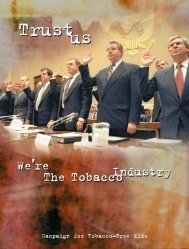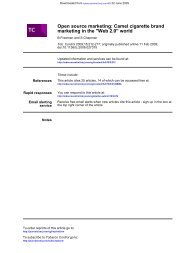National Cancer Prevention Policy - Tobacco Control Supersite
National Cancer Prevention Policy - Tobacco Control Supersite
National Cancer Prevention Policy - Tobacco Control Supersite
Create successful ePaper yourself
Turn your PDF publications into a flip-book with our unique Google optimized e-Paper software.
Australian <strong>National</strong> <strong>Tobacco</strong> Strategy 2004–200<br />
Current national and inter-jurisdictional tobacco control policy is articulated in the<br />
Australian <strong>National</strong> <strong>Tobacco</strong> Strategy 2004–2009. The strategy sets out the intentions<br />
of federal, state and territory governments to work together and collaborate with nongovernment<br />
agencies on a long-term, comprehensive, evidence-based and coordinated<br />
national plan ‘to significantly improve health and to reduce the social costs caused by, and<br />
the inequity exacerbated by, tobacco in all its forms’ (MCDS 2004).<br />
The <strong>Cancer</strong> Council endorses the objectives of the <strong>National</strong> <strong>Tobacco</strong> Strategy, which are,<br />
across all social groups:<br />
•<br />
•<br />
•<br />
•<br />
to prevent uptake of smoking<br />
to encourage and assist as many smokers as possible to quit as soon as possible<br />
to eliminate harmful exposure to tobacco smoke among non-smokers<br />
where feasible, to reduce harm associated with continuing use of and dependence on<br />
tobacco and nicotine.<br />
The <strong>National</strong> <strong>Tobacco</strong> Strategy identifies the following areas for action:<br />
•<br />
•<br />
•<br />
•<br />
•<br />
•<br />
•<br />
•<br />
regulation of tobacco<br />
»<br />
»<br />
»<br />
»<br />
»<br />
»<br />
promotion<br />
place of sale<br />
price (through tobacco tax)<br />
place of use<br />
packaging<br />
products<br />
promotion of Quit and Smokefree messages<br />
cessation services and treatment<br />
community support and education<br />
»<br />
»<br />
informing the community<br />
preventing smoking uptake by children<br />
addressing social and cultural determinants of health<br />
tailoring initiatives for disadvantaged groups<br />
research, evaluation, monitoring and surveillance<br />
workforce development.<br />
Regulation of tobacco promotion<br />
Comprehensive bans on cigarette advertising and promotion were shown to reduce<br />
consumption, but more limited partial bans were found have little or no effect in data from<br />
1970 to 1992 from 22 high-income countries (Jha & Chaloupka 1999). Econometric studies<br />
in high-income countries suggest that comprehensive bans on promotion reduce demand<br />
for tobacco by around 7% (CDCP 1999). When governments ban tobacco advertising in<br />
one medium, the tobacco industry will substitute advertising in other media with little or<br />
no effect on overall marketing expenditure (Jha & Chaloupka 1999). In Australia, tobacco<br />
promotion still occurs at point of sale and on packaging. Research suggests that such<br />
advertising increases positive feelings about cigarette brands (MCDS 2004).<br />
2 Section One: Preventable risk factors




